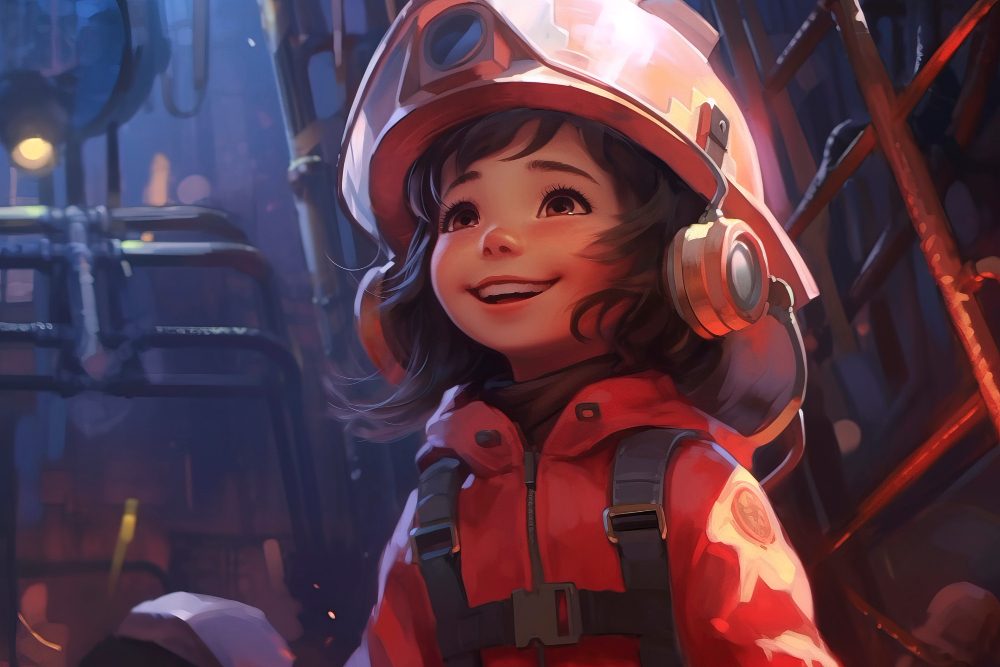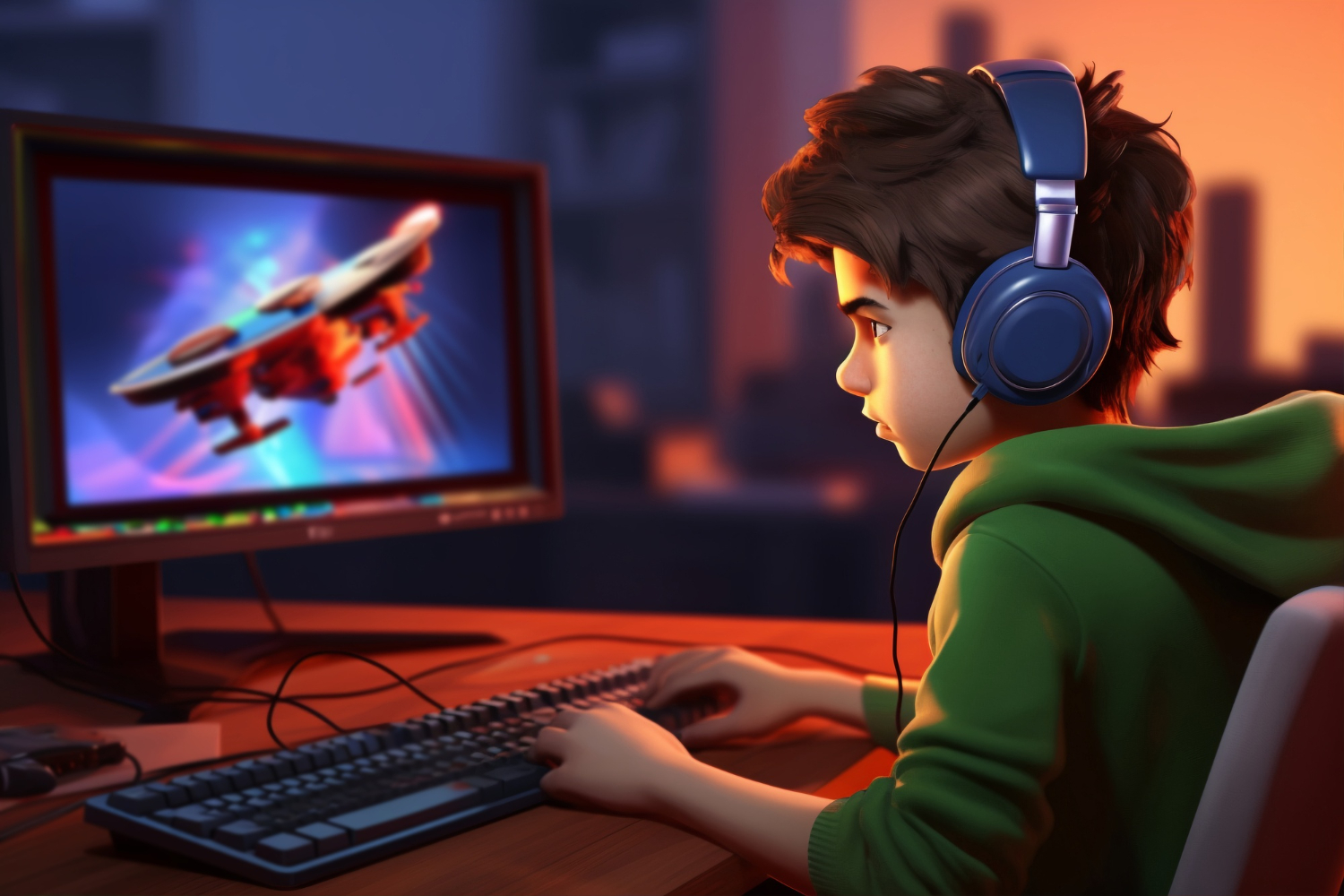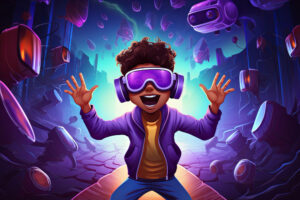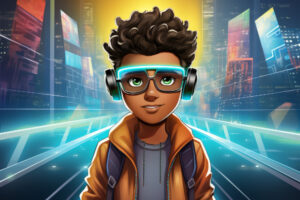In game development, game art and 3D character modeling is absolutely crucial. It’s the craft of breathing life into virtual characters, making gameplay experiences richer with compelling heroes, villains, and side characters. Whether it’s building relatable heroes or spine-chilling villains, 3D character modeling plays a pivotal role in shaping the immersive stories that make today’s games so captivating.
This blog serves as your comprehensive guide to mastering the intricate art of 3D character modeling. From understanding the fundamentals of 3D character creator to exploring advanced techniques, embark on a journey that unlocks the secrets behind game art and creating captivating virtual personas that transcend pixels and polygons.
Understanding 3D Character Modeling
What is 3D Character Modeling?
3D character modeling is the process of creating digital representations of characters in three-dimensional space. Unlike traditional 2D artwork, 3D character models can allow for depth and perspective, making characters appear more lifelike and immersive. This process involves shaping the 3D characters geometry, adding textures and colors, and preparing them for animation. 3D character modeling is a crucial step as it forms the foundation for how characters will interact within the game world.
3D character modeling also involves consideration of technical constraints such as polygon count and texture resolution to ensure optimal performance within the game engine. Additionally, 3D character modeling often goes hand in hand with 3D character design, where artists collaborate to translate conceptual ideas into tangible digital assets. The ultimate goal of 3D character modeling is to create visually compelling and technically efficient assets that enhance the player’s gaming experience and contribute to the overall success of the game.
Types of 3D Character Modeling
Polygonal Modeling:
This is the most common method, where characters are built using interconnected polygons to create textures that form their basic shape. Polygonal modeling allows for flexibility and detail, making it suitable for creating characters with intricate features.
Primitive Geometric Shapes:
Another method involves starting with basic geometric shapes like spheres, cubes, and cylinders, and gradually sculpting them into the desired character form. This approach is useful for creating stylized or abstract characters, providing a versatile approach to crafting unique 3D characters.
Sculpting:
Sculpting software allows artists to mold digital clay directly, mimicking traditional sculpting techniques. This method is ideal for creating organic, highly detailed animated characters, with natural shapes and textures.
Detailed step-by-step 3D character Design Process
It’s very difficult to create characters with 3D effects. Take another closer look into the process.
The character design process starts with conceptualization, brainstorming ideas and considering the character’s role, personality, and appearance. Next, rough sketches or digital concept art explore different poses and expressions. Basic geometric shapes establish the character’s form, followed by sculpting to refine details like facial expression and clothing folds. Texturing adds color and shading, while rigging enables animation. Animation brings the character to life, conveying emotion and personality. Testing and iteration refine the character’s design, rigging, and animation for optimal performance. Finally, assets are finalized and integrated into the game engine.
Tools and Software for Character Modeling
Traditional Modeling Software:
Programs like Autodesk Maya, 3ds Max, and Blender are widely used for 3D character modeling. These software packages offer a range of tools for modeling, sculpting, and texturing 3d characters together, making them suitable for various skill levels and project requirements.
Specialized Software:
In addition to general-purpose modeling software, there are specialized tools tailored specifically for character creation and video editing. Software such as ZBrush and Mudbox focus on sculpting and detailing, while platforms like 3DAiLY offer comprehensive solutions for novice and expert character designers alike.
Game Engines:
Game engines like Unity and Unreal Engine not only facilitate the game development process but also include features for character modeling and animation. These engines provide real-time rendering capabilities, allowing developers to see how characters will look and move within the game environment during the development process.

Preparing for Character Modeling
Concept Art and Character Design
Before diving into the actual character modeling type the process, it’s crucial to have a clear vision of the character’s appearance and personality. Concept art serves as the blueprint for the character, depicting details such as facial features, body proportions, clothing, and accessories.
3D Character designers work closely with concept artists to develop sketches and illustrations that capture the essence of the character. These visual references provide a solid foundation for the modeling process and ensure consistency throughout the design iteration.
Creating Basic Shapes and Forms
Once the concept art is finalized, the next step is to translate those 2D designs into 3D models. This typically begins with creating basic shapes and basic forms, that serve as the building blocks for the character. Artists use modeling software to sculpt primitive geometric shapes such as spheres, cubes, and cylinders, and manipulate them to match the proportions outlined in the concept art.
This initial stage lays the groundwork for the more detailed sculpting and refining process into detailed model that follows.
Understanding Geometric Mesh and Polygonal Model
Geometric mesh and polygonal modeling are fundamental concepts in 3D character modeling. The geometric mesh refers to the wireframe structure that defines the shape of the character in three-dimensional space. The geometric mesh refers to the network of vertices, edges, and faces that define the 3D model’s structure. Artists must pay attention to the flow and density of polygons, ensuring smooth deformations and realistic proportions during animation.
Additionally, understanding the surface characteristics of polygonal models, such as smoothing groups and vertex normals, helps maintain the integrity of the polygon modeling model’s appearance across different viewing angles and lighting conditions.
Creating 3D Characters Process
Creating the Initial Model
With the basic shapes in place, artists begin the process of sculpting the initial model. This involves refining the proportions of secondary character, adding bulk to key areas like the torso and limbs, and establishing the primary features of the character. Artists may use sculpting software to manipulate the digital clay, shaping it into the artist creates desired form with tools like brushes, sculpting layers, and dynamic topology.
Refining the Model for Visual Appeal
Once the initial model is sculpted, attention turns to refining its appearance for visual appeal. This includes adding finer details such as muscle definition, wrinkles, clothing folds, and facial features. Character Artists employ various techniques like surface detailing, texture painting, and displacement mapping to enhance the realism and intricacy of the model.
Throughout this process, artists continually iterate and refine the model based on feedback and artistic judgment, striving to achieve a balance between aesthetics and functionality of smooth model.
Adding Details and Textures
With the model’s sculpting complete, the next step is to add textures and materials to bring it to life. Texture artists use software like Substance Painter or Photoshop to create detailed texture maps that define the surface properties of the model, including color, roughness, and specular highlights. These textures are then applied to the model’s surface using UV mapping techniques, ensuring that they align correctly and enhance the overall visual fidelity of the character.
Rigging the Character for Animation
The final stage of the 3D and character model creation process involves rigging the model for animation. Rigging is the process of adding a digital skeleton, or rig, to the character model, along with controls that allow animators to manipulate its movement and expression. This involves placing joints at key points of articulation, such as the shoulders, elbows, and knees, and creating a hierarchical structure that defines how these joints interact.
Rigging also includes setting up constraints, deformers, and other mechanisms to ensure smooth and natural-looking animations, from basic movements like walking and jumping to complex actions like facial expressions and hand gestures.
Character Animation process
Character animation breathes life into the digital creations of game developers. It’s the process of giving movement and personality to characters within game. Through animation, characters can convey emotions, perform actions, and interact with their environment, enhancing the player’s immersion and engagement. From subtle facial expression and animated character texturing to dynamic combat sequences, character animation plays a crucial role in storytelling and gameplay mechanics.
Rigging Process and Animation Tools
The rigging process is essential for enabling character animation. It involves creating a skeletal structure, or rig, inside the 3D model, complete with joints and controls that allow animators to manipulate the character’s movement. Rigging tools and techniques vary depending on the complexity of the the character’s geometric mesh, and the desired range of motion. Animation software such as Autodesk Maya, Blender, and 3ds Max provide robust character rigging and tools, along with features like inverse kinematics (IK), constraints, and skinning to streamline the process.
Motion Capture vs. Manual Animation
Character animation can be achieved through motion capture technology or manual keyframe animation. This involves recording the movements of real actors or performers and mapping them onto digital characters. This method yields realistic and natural-looking animations but requires specialized equipment and post-processing to refine the captured data. The choice between motion captures and manual animation depends on factors such as budget, project scope, and artistic vision.
Bringing Characters to Life: Facial Expression and Body Movements
Facial expressions and body movements are crucial elements of character animation, conveying emotions, intentions, and personality traits to players. Animators use a combination of rig controls, morph targets, and blend shapes to articulate facial expressions, from subtle smiles to exaggerated grimaces.
Similarly, body movements such as walking, running, jumping, and combat actions are choreographed with attention to weight, timing, and physical realism. By mastering the nuances of facial and body animation, characters can resonate with players on a deeper emotional level, enriching the gaming experience.
Texturing and Rendering for Character Creation
Texture Mapping Techniques
Texture mapping is a crucial aspect of 3D character modeling, as it adds depth, detail, and realism to the model’s surface. There are various techniques used, including:
UV Mapping: This technique involves unwrapping the 3D model surface into a 2D space, creating a UV map that defines how textures are applied to different parts of the model. Artists meticulously arrange UV islands and normal map to optimize texture resolution and minimize distortion, ensuring that textures align correctly with the model’s geometry.
Procedural Texturing: Procedural textures are generated algorithmically rather than being painted by hand. Character Artists can create complex patterns, gradients, and surface effects using procedural textures. This allows for efficient management and consistency in texture application across all 3D characters within the game environment.
Texture Painting: Texture painting involves manually painting textures onto the model surface using digital painting software like Photoshop. Artists can add intricate details, weathering effects, and custom designs directly onto the model, allowing for precise control over the final appearance of 3D characters, including abstract models.
Using Substance Painter for Texturing
Substance Painter is a powerful texturing tool widely used in the game development industry for its intuitive workflow and advanced features. The software offers a range of texture painting tools, including brushes, masks, and smart materials, allowing artists to achieve realistic surface effects with ease.
Substance Painter also supports material layering and non-destructive editing, enabling artists to experiment with different textures and variations without affecting the underlying model of 3D characters.
Achieving Realistic Display with Normal Maps
Normal maps simulate surface details and geometry without adding polygons. By encoding surface normals in RGB values, they create depth and texture on the model surface when rendered. Artists can generate them from high-polygon models or use specialized software. Applied to low-polygon models, they enhance visual fidelity, adding wrinkles, creases, and fine details that react realistically to lighting and shading.
Rendering Characters in Game Environments
Rendering characters in game environments involves optimizing the three dimensional model and textures for real-time performance within the game engine. Game engine like Unity and Unreal Engine offer advanced rendering capabilities, including dynamic lighting, shadows, and post-processing effects, to create immersive and visually stunning game worlds. Artists work closely with developers to ensure that characters are properly integrated into the game’s narrative and environment, taking into account factors like lighting conditions, scene composition, and performance constraints. By leveraging the modern game engines, developers can achieve the most realistic display of characters, enhancing the player’s gaming experience and immersion.
Integrating Game Character into Game Development
Incorporating Characters into the Game World
Integrating game character seamlessly is essential for creating an immersive player experience. This involves placing characters within the game environment, defining their interactions with other elements such as objects, obstacles, and non-player characters (NPCs), and ensuring that they behave and react believably to the game’s dynamics. Character placement, pathfinding, and AI behavior are key considerations in this process, as they determine how characters navigate and interact with their surroundings.
Considering the Game Narratives and Visual Style
The game’s narrative and visual style play a crucial role in shaping the design and presentation of game characters. Characters should reflect the game’s overarching story, themes, and setting, serving as vehicles for storytelling and player engagement. Visual consistency, art direction, and character design principles are important factors concept artists to consider, ensuring that characters align with the game’s aesthetic and contribute to its overall atmosphere and tone.
Challenges in Integrating Game Characters and Solutions
Technical Constraints:
Challenge: Incorporating game character into the environment can be hindered by technical limitations such as memory constraints, polygon count, and processing power.
Solution: Employing efficient rendering techniques like LOD optimization and texture streaming can help mitigate technical constraints, ensuring smooth performance without compromising visual quality. This optimization is crucial in achieving a game changer in terms of graphical fidelity while navigating the complex process of integrating characters seamlessly into the game environment.
Performance Optimization:
Challenge: Ensuring optimal performance while integrating game character involves optimizing animations, AI routines, and rendering processes to maintain consistent frame rates and minimize lag.
Solution: Implementing advanced optimization techniques such as occlusion culling, batch rendering, and dynamic LOD systems can help improve performance, allowing for immersive experiences. With these techniques, developers can keep up with the very popular trend of demanding graphics in modern games while navigating the challenges of integrating characters into a three-dimensional environment.
Optimizing the 3D character model is crucial for maintaining smooth performance without compromising visual quality, ensuring that players can fully immerse themselves without encountering lag or slowdowns.
Maintaining Artistic Integrity:
Challenge: Balancing technical constraints with artistic vision poses a challenge in 3D character integration, as developers strive to maintain visual fidelity and narrative coherence while adhering to performance requirements.
Solution: Collaboration between multidisciplinary teams of artists, designers, and developers is key to finding creative solutions that enhance the player experience while exceeding customer expectations. By fostering communication and teamwork, developers can overcome the complexities of integrating game characters into static 3D character models and three-dimensional environment, paving the way for further development and innovation in the gaming industry.
This collaboration ensures a schematic model for success, where a large talent pool and a professional team work together to deliver results that exceed customer expectations.
Advanced Techniques and Best Practices
Creating Detailed Characters and Environments
When it comes to creating detailed 3D character model and environments, attention to detail is key. This involves not only focusing on the primary features of characters but also considering secondary elements like clothing, accessories, and environmental props. Artists use techniques such as sculpting, texture painting, and procedural generation to add depth and complexity to their creations.
Ensuring consistency across characters, including 3D characters, is crucial to maintain visual coherence throughout the game. Furthermore, understanding the importance of the first and last frames in three dimensional character helps to create smooth transitions and engaging storytelling experiences for players.
Optimizing Models for Performance
Optimizing models for performance is essential for ensuring smooth gameplay and optimal frame rates, particularly in resource-intensive games. This involves reducing the polygon count of models, simplifying geometry where possible, and optimizing texture resolution and compression. Techniques such as LOD (Level of Detail) management and occlusion culling help streamline rendering processes and improve overall performance without sacrificing visual quality.
By prioritizing performance optimization during the development process, developers can ensure that their games run smoothly on a wide range of hardware configurations. This is especially important considering the steep learning curve and the complexity involved in creating 3D characters and character model. Failure to optimize can result in performance issues that can disrupt gameplay and diminish the player’s experience, potentially impacting the success of even entire projects. Therefore, mastering optimization techniques is crucial for game developers looking to create high-quality games that are both visually impressive and performant.
Ensuring Consistency Across Characters
Consistency across characters is crucial for maintaining the visual coherence and immersion. This involves establishing a cohesive art style, character design guidelines, and asset libraries to ensure that all characters fit seamlessly within the game universe.
Consistency in character models, including 3D characters, ensures that the overall aesthetic remains cohesive and enhances the player’s engagement with the game. Furthermore, attention to detail in character texturing contributes to the realism and immersion, reinforcing the importance of consistency in every aspect of character design and development.
Exceeding Customer Expectations
Exceeding customer expectations is the ultimate goal of any game development project. This involves not only delivering on promised features and content but also surprising and delighting players with unexpected details, innovations, and experiences. By actively soliciting feedback from players and incorporating it into the development process, developers can identify areas for improvement and implement changes that enhance the overall quality of the game.
It’s crucial for all your employees to understand the importance of exceeding customer expectations, as it fosters loyalty and drives success in a competitive market. Furthermore, offering high-quality games at an approximate price that reflects their value ensures accessibility and fairness for players, further enhancing their overall experience with game character and 3D characters alike.
The Future of 3D Character Modeling
The future of 3D character modeling is driven by emerging trends and technologies, such as real-time rendering, machine learning, and procedural generation. These advancements enable artists to create more realistic and dynamic 3D characters than ever before. Additionally, trends like virtual production, cloud-based rendering, and remote collaboration are transforming game development, offering new avenues for creativity and innovation.
Real-time rendering is revolutionizing game development, offering immersive experiences on multiple platforms. Virtual reality (VR) and augmented reality (AR) enhance 3D character modeling, enabling new interactive experiences. As VR and AR evolve, they will shape the future of gaming and entertainment.
The future of 3D character modeling is full of opportunities for further development and innovation. This includes exploring new techniques for character creation, such as procedural modeling and generative adversarial networks (GANs), as well as leveraging emerging technologies like volumetric capture and photogrammetry. Additionally, the growing demand for diverse representation and inclusivity in games presents an opportunity for artists to explore new approaches to character design and storytelling. By embracing these opportunities for development and innovation, the future of 3D character modeling holds limitless possibilities for creativity and expression.
Conclusion
In conclusion, mastering 3D character modeling is essential for creating immersive and captivating game experiences. Throughout this guide, we’ve explored key concepts such as character design, texturing, and optimization, emphasizing the importance of attention to detail and consistency. Professional teams with diverse skill sets play a crucial role in bringing characters to life, ensuring that they meet performance requirements and customer expectations. By leveraging the talent pool of in-house employees and external resources, game developers can achieve high-quality results while managing costs effectively. Whether you’re creating static models or dynamic game characters, investing in professional teams and talent is paramount to success. Ready to embark on your 3D character modeling journey? Take the next step with 3DAiLY and create game character today.




